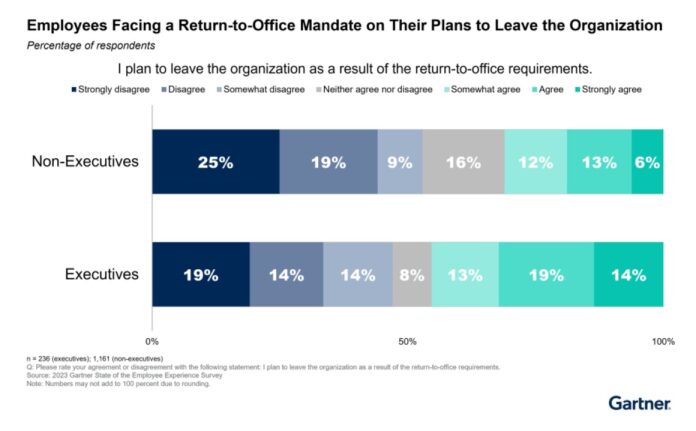A third of executives say they would leave their organization if it requires employees to return to the office, compounding HR’s challenge of retaining a strong leadership team, according to a recent Gartner report.
The flight risk is concerning because, according to a 2023 Gartner survey of 520 HR leaders across a number of industries and regions, 80% of CHROs do not think they have a deep list of possible replacements for senior roles.
“If a mandate is put in place and a lot of executives leave, it’s a huge risk not to have a strong bench to fill those roles,” says Caitlin Duffy, research director in Gartner’s human resources practice. “That’s because it cascades down and impacts all the levels below and can be difficult to manage.”

Not only do 33% of the 236 executives surveyed in this year’s report say they plan to leave their employer because of a return-to-office requirement, but last year’s Gartner report found 36% of senior managers have left a job as a result of a required RTO policy, the current Gartner report notes.
One surprising finding: Nearly 60% of executives surveyed say their organizations provide convincing reasons for “instituting an RTO policy,” though Gartner did not define what that policy might entail. Despite understanding the need for such a policy, many would not want to submit to it, according to Gartner.
Executives typically have greater insights into their company’s operations, data and other information, Duffy says, so return-to-office decisions can make more sense to them than to the rest of the workforce. However, that doesn’t seem enough to retain all executives, she says.
For the past few years, HR leaders have struggled to entice employees back to the office, leading, in some cases, to heated exchanges between HR and employees. Amazon workers, for example, staged a walkout last year over its RTO policy. While much of the focus of return-to-office has been on non-executive employees, Duffy advises HR leaders to pay attention to executive reactions, too.
Why a high number of executives are leaving post-RTO policy
Potential catalysts for executive departures include concerns about decreased work/life balance and productivity and losing the autonomy to decide how and when they work, Duffy says. All of these can signal distrust from the employer, driving executives to seek a better fit elsewhere.
She says disagreements over how the office attendance policy came to be can also prompt an executive to leave.
“If they were involved in the decision for an RTO policy, they may be unhappy with the way it went and felt their voice wasn’t heard,” Duffy adds.
Risks of a massive leadership exodus
Duffy says executive departures can severely threaten an organization’s operations, especially if attrition is already high.
What’s more, succession planning can be dangerously impaired if a third of executives leave following a mandated RTO policy, Duffy says, pointing to the large gap it would create in a succession pipeline of experienced employees.
“We hear from CEOs and HR leaders that there are really significant risks to the organization by having those leadership roles open,” Duffy says. “That’s because they are critical roles for operating effectively.”



